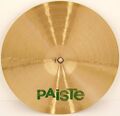Difference between revisions of "Paiste 505"
| Line 57: | Line 57: | ||
=== Concert === | === Concert === | ||
| − | * '''[[Paiste Concert|Concert]] - [[Paiste 505 20" Concert|20"]]<br> | + | * '''[[Paiste Concert|Concert]] - [[Paiste 505 18" Concert|18"]] [[Paiste 505 20" Concert|20"]]<br> |
Revision as of 14:44, 27 September 2021
505
Introduction: 1978
Discontinued: 1986 (German factory offered 505s until 1993!)
Background: The successor to the long-running Stambul series, Paiste 505s were released to the public in 1978 and slotted in under the 2002.
It appears production of the line might of begun in the Swiss factory staring as early as 1974.
There are definitely oddball sizes and types out there that were produced during the transition from the Stambul B8 line and cymbals with both a Stambul emboss and a 505 hand stamp logo exist (see pictures below).
Early Swiss-made Black Label 505s have a single line hand stamp which was later changed to a double line stamp mirroring the 2002 logo, probably in the latter part of 1978 or early in 1979.
German-made Black Label 505s seem to always have a single line hand stamp also, the German factory used a different serial system* than the Swiss factory (see German serial number breakdown below).
The transition to the Green Label silk screened logo begins in 1981. There are a substantial amount of Green Label 505s out there with no serial number.
At least some German Green Label 505s made in 1983 have a logo variant with a hollow crescent moon and star (picture on the right).
The line gains new sizes and types (and weight) during the Green Label phase before it is discontinued in 1986 (The German factory continued to offer 505's in their catalogs until 1993) and replaced in price point by the 1000 series and in spirit by the 2000 series. The 505s were one of the best values in the history of cymbals, and fought well-above their weight class (sources state that Paiste was losing money on the 505 line: they were 35% cheaper than an equivalent 2002 but required almost the same amount of labor to produce).
U.S. availability
- Rogers never listed 505's in their catalogs or distributed them in the U.S. from 1978 to 1980 (no black labels were sold in the U.S.)
- 505's were not available in the U.S until ~1981 when Paiste opened their North American distribution center, by then they had the printed "green stamp" logo along with an expanded selection of models and sizes.
Innovation:
Alloy: CuSn8 (Also known as "2002 Bronze")
Quality: "A truly affordable pro-quality cymbal at the student or semi-pro level. Paiste experience, craftsmanship and understanding of choice materials give these cymbals many professional features".
Production: Cast cymbals using more mass production (automated) manufacturing methods with some manual hammering
Applications: All types of music, particularly pop and rock
Users:
Sound: "505 cymbals produce a fully resonant, vibrant sound. They are developed to provide the drummer with a good quality cymbal. All Paiste 505 cymbals give a true professional cymbal sound with clear character definition.
The ride cymbals have strong definite stick-rhythm sound. The multi-purpose medium cymbals can be used for loud, forceful crash or gentle ride effects, crash cymbals give compact, cutting accents."
Early 80's model and size additions can be seen in green below:
Rides
- Heavy Ride - 18" 20" 22"
Crashes
- Heavy Crash - 16" 18" 20"
Hi-Hats
Chinas
- China Type - 14" 16" 18" 20"
Splashes
Europe only (or U.S. special order):
Concert
Initial 505 listing in Paiste's European 1978 catalog (same sizes/weights as the Stambul series)
Thin
Medium
Heavy
Hi-Hats
(*)German made 505's used a different serial numbering format system compared to the Swiss system: (they are numbered consecutively), the first digit does not equal the year.
The second digit is a good general indicator of the year, here's a breakdown (these dates are not exact):
1974-1979 serial numbers : 10xxxx-20xxxx (17xxxx serial is from around 1977 or 1978. a lower third digit: 171xxx -174xxx most likely = 1977 while a higher third digit 175xxx - 179xxx puts you around 1978)
(another example: #196181 late 70's)
1980 serial numbers: 20xxxx - 21xxxx
1981-1986 serial numbers: 22xxxx-3xxxxx (example: #228044 early 80's)
1986-1990 serial numbers: 3xxxxx-4xxxxx (example: #333994 mid 80's, #418074 late 80’s).
Confirmed specific dates from the German factory:
serial# 2612xx produced in November 1983
serial# 2984xx produced in October 1984
serial# 3244xx produced in August 1985
(Right before Paiste went to the printed color logos it looks like production increased and they started going through serials at a faster rate.)
Information from: Paiste catalogs, Todd Little, Dan Garza
1979 Paiste catalog
1985 Paiste catalog
Return to the Paiste Series Portal
Return to the Paiste Cymbal Type Portal





















